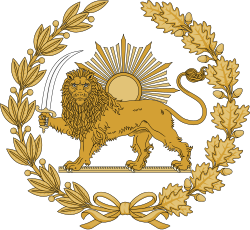獅子與太陽
此條目的引用需要清理,使其符合格式。 (2014年7月10日) |
此條目需要補充更多來源。 (2014年7月10日) |
獅子與太陽(波斯語:شیر و خورشید,Šir o Xoršid)是伊朗的一個主要象徵,並且在1846年到1980年間是伊朗國旗上的主要元素。這個在古代和現代都被不斷描繪的主題在十二世紀時成為了伊朗的流行符號。[1]獅日符號主要根據天文學和占星學結構繪製: 一種太陽在獅子宮的古老符號,[1][2]最早可追溯至巴比倫人的巴比倫占星術和近東傳統。[2][3]
| 獅子與太陽 شیر و خورشید | |
|---|---|
 獅子與太陽 | |
| 細節 | |
| 啟用 | 1846年(由穆罕默德沙·卡扎爾的法令啟用) |
| 其他元素 | 太陽和爪持佩劍的獅子 |
| 使用 | 前伊朗軍裝,1846年到1980年間的伊朗國旗 |

該主題有許多歷史意義。首先,它是一個占星術和黃道兼有的符號。在薩非沙阿和早期幾個卡扎爾沙阿統治時期,它與什葉派的聯繫日益緊密。[1]在薩非王朝時期,獅日標誌代表帝國的兩大支柱——國家和伊斯蘭宗教。它在卡扎爾王朝時期提擢為波斯的國家象徵。十九世紀時,在卡扎爾沙阿庭院的歐洲遊覽者將獅日歸類為遙遠的古風;那時起,它引發了民族主義的解釋。[1]但在法特赫-阿里沙·卡扎爾和他的繼任者統治時期,這一主題卻被大幅修改了。一個皇冠也被添加到這個符號上以宣示王權。法特赫-阿里統治早期,伊斯蘭對帝國的影響逐漸式微。這一轉變影響了這一符號的象徵主題。該符號的象徵意義在卡扎爾時期與1979年革命時期間不停轉變。獅子可解釋為比喻阿里,也可解釋為那些隨時保護國家抵禦外敵的英雄們,還可解釋為王權的古老象徵。太陽也可選擇性解釋為國王,傳說中的君主賈姆希德,或祖國。
該象徵的許多歷史解釋為伊朗民族身份的象徵競爭提供了堅實基礎。二十世紀時,部分政治家和學者建議將諸如卡維之旗等其他物品設為國家象徵,替代獅日。但是該標誌卻一直擔任伊朗國家象徵,直到1979年革命時獅子與太陽才被從公共場合和政府組織標識中抹去,代之以現在的伊朗國徽。
圖集
編輯其他非伊朗變種
編輯參見
編輯註解
編輯- ^ 1.0 1.1 1.2 1.3 (Shahbazi 2001)
- ^ 2.0 2.1 (Kindermann 1986)
- ^ (Krappe 1945)
- ^ (Nafisi 1949)
參考資料
編輯- Babayan, Kathryn, Mystics, monarchs, and messiahs: cultural landscapes of early modern Iran, Harvard College: 491, 2002 [2014-07-10], ISBN 0-932885-28-4, (原始內容存檔於2014-09-16)
- Barker, Patricia L., Islamic Textiles, British Museum Press: 137, 1995, ISBN 0-7141-2522-9
- Burchill, Richard, N. D. White, Justin Morris, H. McCoubrey, International conflict and security law: essays in memory of Hilaire McCoubrey, Vol. 10, Cambridge University Press: 92, 2005, ISBN 9780521845311
- Eskandari-Qajar, Manoutchehr M., Emblems of Qajar (Kadjar) Rulers: The Lion and the Sun, The Qajar(Kadjar) Pages, 2009 [2009-10-10], (原始內容存檔於2021-02-25)
- Fuat Köprülü, Daneshnameye Jahan-e Eslam(Encyclopaedia of the World of Islam From Encyclopedia of Turk), Bayrak, The Encyclopaedia Islamica Foundation, (原始內容存檔於2010-11-04) (波斯語)
- Joseph, Suad; Najmabadi, Afsaneh, Encyclopedia of Women & Islamic Cultures: Family, law, and politics, Netherlands: Brill Academic Publisher: 524, 2002
- Kindermann, H., Al-Asad, Encyclopedia of Islam 1, Leiden, the Netherlands: E.J.Brill: 681–3, 1986
- Khorasani, Manouchehr M., Arms and Armor from Iran: The Bronze Age to the End of the QajarPeriod. First, Germany: Verlag, 2006
- Krappe, Alexander H., The Anatolian Lion God, Journal of the American Oriental Society (American Oriental Society), Jul–Sep 1945,, Vol. 65, (No. 3): 144–154, JSTOR 595818
- Marashi, Afshin, Nationalizing Iran: Culture, Power, and the State, 1870-1940, Published by University of Washington Press, 2008
- Nafisi, Saeed, Derafsh-e Iran va Shir-o-Khoshid (The Banner of Iran and the Lion and the Sun), Tehran: Chap-e Rangin, 1949 (波斯語)
- Najmabadi, Afsaneh, II, Gender and sexual anxieties of Iranian Modernity, University of California Press, 2005, ISBN 0-520-24262-9
- Shahbazi, Shapur A., Flags (of Persia), E. Yarshater; et al (編), Encyclopaedia Iranica 10, 2001 [2014-07-10], (原始內容存檔於2016-03-04)
外部連結
編輯- Shahbazi, Shapur A. Flags (of Persia). Encyclopaedia Iranica 10. 2001 [2014-07-10]. (原始內容存檔於2016-03-04).